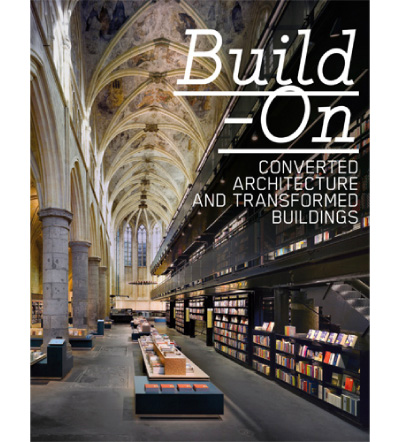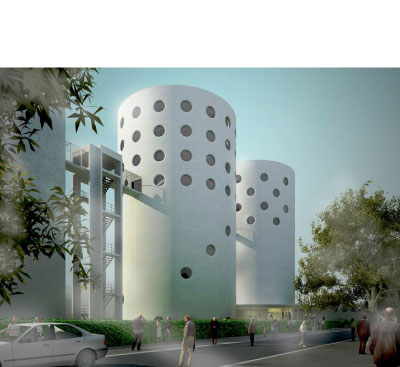In terms of lifespan, architects are the opposite of rock stars. They tend to live long and do great work after their 80th birthday. Philip Johnson was still designing when he died at the age of 98. As you read this, Oscar Niemeyer, now 101, is probably scheming up his next project. Frank Lloyd Wright checked out at 91, six months before his Guggenheim Museum was to open. But Eero Saarinen is an exception. When the Finnish-born architect and furniture designer died at 51 (with nine buildings in progress), he was as famous as an architect could be. He’d designed a slick new landmark for St. Louis (the Gateway Arch) and had been on the cover of Time magazine. Perhaps most indicative of his place in 1950s America, President Eisenhower was scheduled to detonate a celebratory atom bomb at the opening of Saarinen’s General Motors Technical Center in Warren, Michigan. But that part of the festivities was cancelled.
Critics have said that Saarinen was too much of a corporate hired gun, designing safe buildings for large companies like CBS and IBM. His office parks, according the New York Times’ Nicolai Ouroussoff, “reinforced the sweeping shifts that reflected the dark side of the postwar era: the racial tensions and white flight, the excesses of the consumer culture, the suburban isolation.” And that may, in part, be true. But he was also behind some undeniably innovative designs. Eero Saarinen: Shaping the Future, a rich survey of his work at the Museum of the City of New York, succeeds at displaying the man’s range.


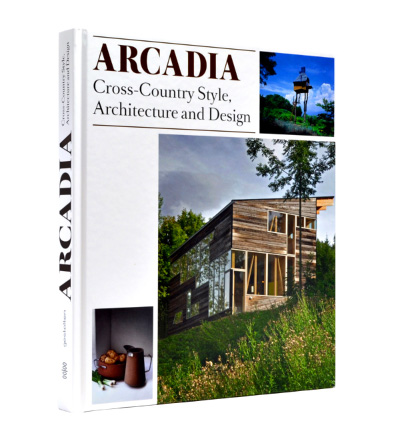
You have to wonder if tea tastes better when sipped in the Too-High Teahouse outside Chino City in Nagano, Japan. It’s a small, whimsical building supported by two chestnut tree trunks. The altitude is meant to have a calming effect on guests. The teahouse’s style is what you could call rustic chic. Or woodsy eclecticism. It’s featured in Arcadia: Cross-Country Style, Architecture and Design (Gestalten; $75), a coffee table book about recent buildings and furniture which are surrounded in, and/or inspired by, nature. The book also showcases faux-rustic bowls and utensils, making some sections seem like a housewares catalog for affluent dwarves. (Dutch designer Jo Meesters’s pitchers made of paper pulp and resin are the best of that group.)

The next time you’re in Luckenwalde, Germany (population 21,000) make sure to visit the local library. It’s weird-looking. The town’s former train station was rehabilitated and repurposed by the firm FF-Architeckten. The children’s section is housed in a modern addition: a tilted rectangle covered in gold scales. The scales are supposedly meant to resemble dragon skin — the same dragons chasing around maidens and knights in the fairytales kids are reading inside. The old train station is plain and traditional; the new wing is anything but. So does it jive? Sure! It’s saying, “This new shiny area is for children. That old gray building is for grandpa.” And any addition with a clever message is good enough for us. It was also good enough for editors Robert Klanten and Lukas Feireiss, who chose it for their book, Build-On: Converted Architecture and Transformed Buildings (Gestalten; $75). Considering that a modern addition on a beloved older building is one thing that will get the average person really pissed at (or at least talking about) architecture, it’s a subject worth exploring and cataloging.

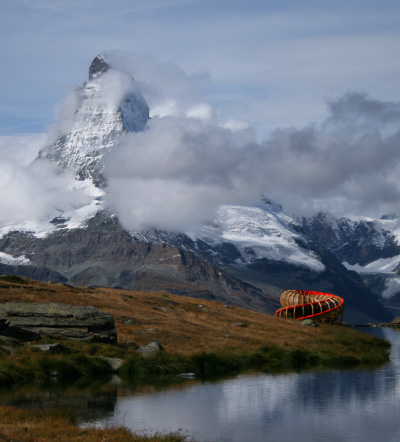
One of the great things about being in college is that you’re not required to produce practical work. Your pseudo-intellectual essays might get a B- if the professor is generous. I was once given an A for a tedious, poorly researched paper on mid-20th century Irish folk music that will never benefit a single person. But some wholly unnecessary, unsolicited work can be great — especially in architecture schools. And double good if it makes it past the pipe-dream phase and is actually built. Case in point: Evolver, a spirally wooden structure near Lake Stelli in Zermatt, Switzerland. It was designed by the students in ALICE, an experimental architecture studio at the Ecole Polytechnique Fédérale de Lausanne. No one actually needed Evolver, but I think I’m glad it exists.
It’s surrounded by some of the most Romantic nature in Europe. Altitude: 2,536 meters. Visitors are supposed to walk up and then down the ramp and experience different vistas through the wood slats. The idea being that the slats make you focus on one spot. It’s controlled nature-loving. Ideally the views are enhanced by Evolver: gazing at the nearby Matterhorn again and again from different angles should drop your jaw even lower. But will it? My initial impression was: What’s so awful about looking up at mountains from grass?


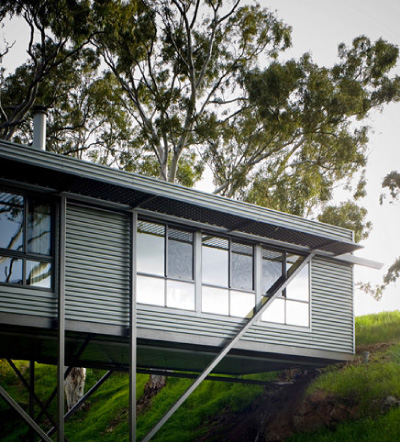
The Bridge House by architect Max Pritchard got a fair amount of press earlier this summer, so we’re a little late to the praise party. But in the interest of giving credit where credit is due, we’d like to gush over this ingenious living/working space that straddles a creek outside of Adelaide, South Australia. Let’s start with money. It only cost $177,000. That’s laughably lower than the average home being published today. Granted, with an area of 110 square meters, Bridge House is relatively small. But a price tag under $200k for such a thoughtfully designed home on a lot this challenging is inspiring: Hey, average non-millionaire, you too could have your house written about in fancy New York City magazines if you hire a clever architect like Mr. Pritchard. Oh, and if you’re ballsy enough to build over a creek’s deep waterhole.
In Australia, they’d call that waterhole a billabong. The clients have a 10-acre site but they wanted their house to be on the bank overlooking the billabong. They didn’t want to significantly alter the gorgeous setting and destroy the billabong, so steel trusses were used to elevate the house. As a commenter on the Web site Archinet reminds us, it’s very reminiscent of an unbuilt project by Craig Ellwood, the influential, yet unlicensed, architect. The best artists always steal, right?

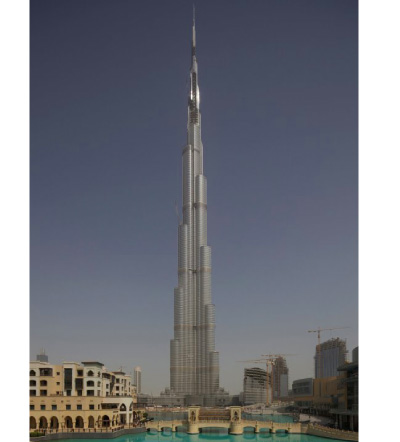
Ah, Dubai. The crazy little emirate known for palm-tree-shaped islands and exploiting South Asian laborers now has another feather in its cap: the tallest building in the world. The Burj Dubai, which is rumored to open December 2, is already taller than Taiwan’s Taipei 101, now the second-tallest building in the world. Designed by Adrian Smith and the skyscraper-efficiency gurus at Skidmore, Owings and Merrill, the Burj Dubai could be as tall as 2,600 feet once finished. While its developer, Emaar Properties, won’t divulge the Burj’s official height or completion date, they have been generous with obnoxious promotional copy: “Burj Dubai will be known by many names. But only a privileged group of people will call it home.” Also on the project’s website is a bewildering image gallery with more borderline artistic photographs than pictures of the actual building.
I don’t mind the tackiness. I just want a new tallest building.

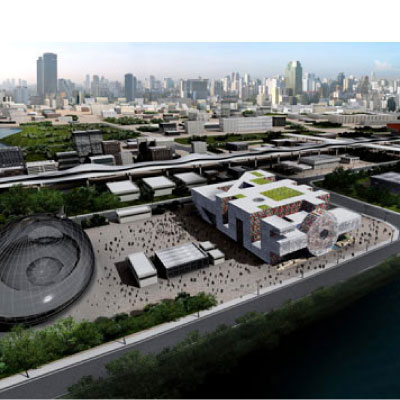
Decades ago, long before an architect could tweet his latest design to bloggers and PR people, world’s fairs were a big deal. The World’s Columbian Exposition, held in Chicago for six months in 1893, attracted 27 million people, about half the U.S. population at the time. Any kid living in or around New York City in 1939 or 1964 no doubt begged his parents for a ticket to the two world’s fairs in Queens. But ask someone today how psyched they are for Expo 2010 in Shanghai, and you’re bound to get a blank stare. While world’s fairs have long since lost their cachet, countries are still sponsoring praiseworthy pavilions. Here are the ones we think will make the biggest splash in Shanghai.


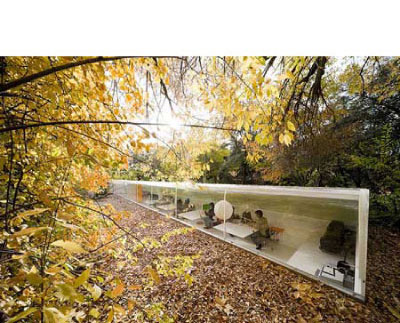
The most common response to the question “What’s your dream home?” is probably something like “A place in the woods, surrounded by nature.” That’s because many of us equate living deep in the forest or high in the mountains with serenity and, if the house is modernist (or better yet, a modernist take on a log cabin!), a sort of rustic sophistication. Think of Frank Lloyd Wright’s Fallingwater; hell, even that vampire family’s house in Twilight. But many of us spend as much or more time at work than we do at home. And many of us work in some of the world’s most demoralizing, low-ceilinged buildings in the busiest and smelliest areas of major cities. So, short of becoming a lumberjack, how should today’s cooped-up white-collar employee dream of escaping his or her miserable workspace? By getting a master’s degree in architecture and applying for a job at Selgascano, a Spanish design firm whose new studio is in the middle of the woods outside Madrid.

In between downtown Amsterdam and a newly developed area to the east called IJburg is the island of Zeeburgereiland. Locals mainly think of Zeeburgereiland (loosely translated: “sea person island”) as an inhabitable island with a massive sewage-treatment plant. But not for long. The plant is being relocated, and Zeeburgereiland is becoming prime real estate. Three large silos once used for treating sewage will remain on the island; one of them has already been converted into office space. The city council recently held a competition to determine how to reuse the other two and, in April, announced the winning design: Arons En Gelauff Architects’ Annie MG Schmidt House, a cultural center named after Holland’s most celebrated children’s book author. But if we were running things, it would have gone to NL Architects’ proposal. Why? Look at these pictures.
In their plan, one silo would be adapted into an indoor climbing center. Its walls taper toward the top and ingeniously end at a roof light. The firm envisioned the climbing silo also being used for weddings, birthday parties and church services.

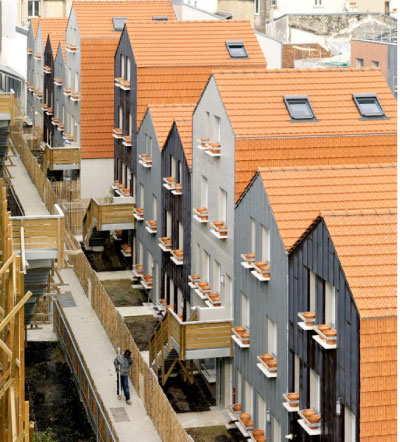
The recently unveiled Villas des Vignoles, in Paris, is the most charming public-housing complex in the world. Occupying one rectangular city block, the two- and three-story dwellings have many features most people don’t associate with the PJs: pitched roofs of varying heights, nooks designated for gardening and composting, vine-covered facades, and rabbit hutches. Yes, rabbit hutches. It’s also called Eden Bio, perhaps because when compared to most subsidized housing around the world, Vignoles is paradise. The rabbits here will likely live better than many people in the city’s less desirable housing projects — with apologies to those that end up as delicious lapin a la cocotte.
Vignoles is getting a good deal of press in part because the bar for public housing is so low. Paris, like all large cities, has its fair share of unfortunate housing projects, and its reputation took a beating after the riots in October and November 2005. While the unrest in the city’s Clichy-sous-Boi neighborhood was reportedly a result of the lack of jobs available for the young, predominately Muslim residents, as well as police brutality, urban planners and other critics also blamed the buildings these kids called home: colonies of tall, concrete slabs which failed to provide residents the slightest feeling of warmth or security. The housing projects had a de-humanizing effect on the immigrants who were placed there and, perhaps even more so, on their children who’d never lived anywhere else.






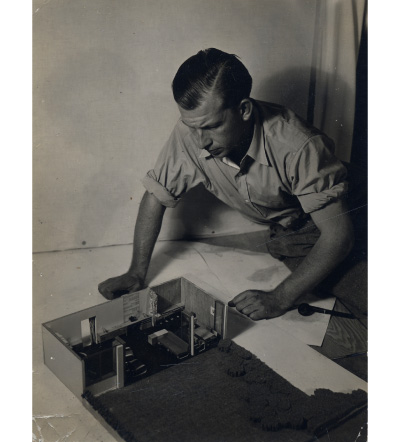
 Facebook
Facebook Permalink
Permalink Digg
Digg Reddit
Reddit LinkedIn
LinkedIn StumbleUpon
StumbleUpon Tumblr
Tumblr